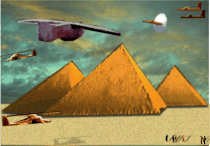Dinosaurs in Literature, Art & History--Another Andean Dinosaur?
Bird Headed or Ceratopsian Headed Figure?... Page 27

Pre-Columbian Crested Dinosaur?

As we've discussed earlier in this section, there are many types of dinosaurs that have yet to be discovered. In addition, of those dinosaurs that have been discovered, it is quite difficult to determine exactly how they appeared in life. We say that to say that we present to you here in our opinion a depiction of a type of crested dinosaur, one that supposedly would have been extinct millions of years before this Andean artist lived.

Click and drag photo to resize.


University of Helsinki
Ibero-American Center
Research Project on South Central Andes
"Formations and transformations of ethnic identities in the South Central Andes, AD 7001825. A multidisciplinary study of tangible and intangible patrimony
© Antti Korpisaari, Risto Kesseli & Martti Pδrssinen 2004
Photos related to Finnish-Bolivian research in the South Central Andes
Fig. 25. (Above) A small dragon peering over the edge of a c. 22-cm-tall kero. Photo Antti Korpisaari.
Source: WWW.Helsinki.Fi
 Click and drag photo to resize.
Click and drag photo to resize.


Here we don't mean to suggest that this Andes crested dinosaur is in fact a "Cryolophosaurus", left or a "T-Rex", center, or a Zupaysaurus rougieri (found in Argentina) as shown in this graphic, only that the identification of this piece as a type of crested dinosaur is a credible one.
LEFT:"Cryolophosaurus ellioti (cry-oh-LOAF-oh-SORE-us, meaning "cold crested lizard") is a large bipedal dinosaur with a bizarre crest running across its head that looks like a Spanish comb. Due to the resemblance to Elvis Presley's pompadour haircut in the 1950s, the dinosaur is also informally known as the Elvisaurus.
Cryolophosaurus was discovered in Antarctica by the paleontologist William Hammer, in 1991. It is the first carnivorous dinosaur to be discovered in Antarctica, and the first dinosaur of any kind from the continent to be officially named. Dating from the early Jurassic, it is also the earliest tetanuran theropod yet discovered, though it is not the most primitive.
Description
Cryolophosaurus was about 6 to 8 meters (20 to 26 feet) long, which is significantly smaller than the largest Allosaurus, which reached up to 12 meters (40 feet) in length"....Answers.com
RIGHT:"Scientists exploring the remote badlands of northwestern China have unearthed the earliest known ancestor of Tyrannosaurus rex, the fierce predatory dinosaur whose image has haunted legends, films and the nightmares of children for more than a century.
The primitive ancestor that lived 160 million years ago was a mere 10 feet long when it was alive, compared to the monster T. rex, who measured more than 40 feet from head to tail and dominated all the dinosaurs on Earth more than 90 million years later. Unlike T. rex, the smaller creature bore a striking but fragile crest atop its head, three fingers on the hands of its surprisingly long forearms and a long, slender snout."
(s8int.com does not believe that this animal was an ancestor of T-Rex, nor in the evolutionary dating scheme. We just wanted you to know what science says about these animals. We believe that the animal depicted lived a short time ago and was seen alive by the artist.)
Click and drag photo to resize.


Compare this Andean dinosaur, left with one we've already presented, right at Page 21. There appear to be a number of similarities.

Bird Headed or Ceratopsian Headed Figure?
Though the Metropolitan Museum of Art describes the figure below as "bird-headed", here at s8int.com we'd like to make a more outlandish suggestion; that this is in fact, clearly the head of a ceratopsian dinosaur.
If we are right, we think the implication inherent in using the head in this manner suggests that for this artist, the ceratopsian dinosaur was a "common" animal. What do you think? We think the association with the ceratopsian is clear. We'd be interested to know what bird this head actually resembles?
Click and drag photo to resize. 
"Bird-Headed Figure Whistle, 8th9th century
Mexico, Veracruz
Ceramic; H. 20 1/4 in. (51.4 cm)
The Michael C. Rockefeller Memorial Collection, Gift of Nelson A. Rockefeller, 1963 (1978.412.80)"

Click and drag photo to resize. 

1, 2, 3, 4, 5, 6, 7, 8, 9, 10
11, 12, 13, 14, 15, 16
17 18, 19,
20,
21,
22,
23,
24,
25,
26,
27,
28,
29,
30,
31,
32,
33,
34,
35,
36,
37,
38,
39,
40,
41,
42,
43,
44,
45,
46,
47
Next>>>


 Home
Home 20th Century Dinosaurs
20th Century Dinosaurs Dinosaurs in Literature, Art & History
Dinosaurs in Literature, Art & History Eyewitness Accounts
Eyewitness Accounts There Were Giants In The Earth in Those Days
There Were Giants In The Earth in Those Days Mega Fauna
Mega Fauna Those Sophisticated "Cave Men"
Those Sophisticated "Cave Men" Search for Noah's Ark
Search for Noah's Ark DNA, The Ultimate Oopart
DNA, The Ultimate Oopart The Bone Yards
The Bone Yards Underwater Cities, Monuments?
Underwater Cities, Monuments? Ancient Atomic Knowledge?
Ancient Atomic Knowledge? Salvation. What Must You Do To Be Saved?
Salvation. What Must You Do To Be Saved? Search
Search Links
Links Guestbook
Guestbook




